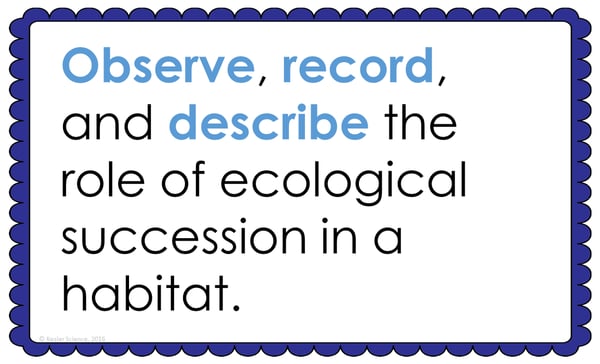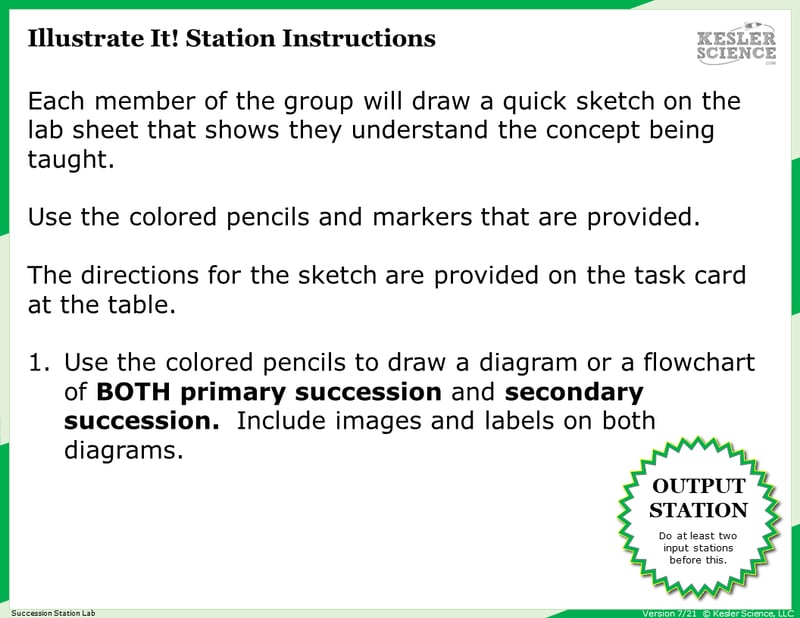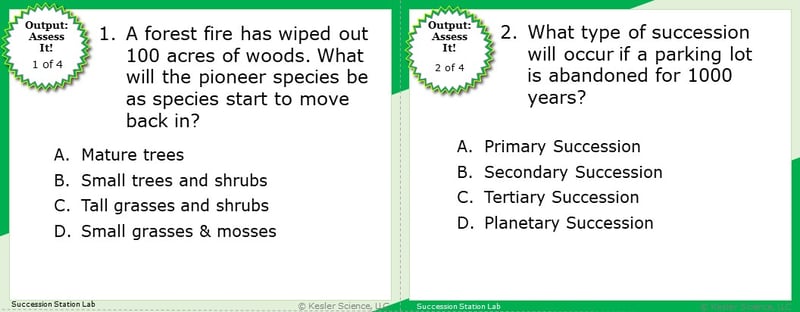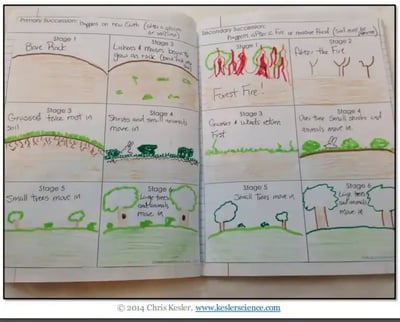Succession Lesson Plan - A Complete Science Lesson Using the 5E Method of Instruction
By the end of this comprehensive lesson about ecological succession, students will be able to observe, record, and describe the role of ecological succession in a habitat. Each of our lessons is designed using the 5E method of instruction to ensure maximum comprehension by the students. This well-thought out unit does the heavy lifting, giving teachers easy-to-implement, highly engaging lesson plans.
This blog will walk you through each of the steps and activities from the Succession 5E Lesson Plan.
ENGAGEMENT
Objective Introduction
At the beginning of the lesson, the class will do a Think-Pair-Share to discuss the objective.
Class Activity
The teacher will show students a slide of Mt. St. Helens using the provided PowerPoint. The teacher will ask students to share and describe what differences they can see in the surrounding area since the eruption.
Student Activity
The teacher will show a YouTube video using the provided link about the eruption of Mt. St. Helens. Students will be asked what changes have occurred since the eruption in 1980. Let students know that this ecological process is called succession.

Afterwards, the teacher will help to clear any misconceptions their students have about succession. A common but major misconception, for example, is that students often don’t understand the reasons why ecosystems undergo changes in the first place - reasons like invasive species, natural disasters, and climate change.
Estimated Class Time for the Engagement: 20-30 minutes
EXPLORATION
This student-centered station lab is set up so students can begin to explore succession. With nine stations in total, you can introduce succession to your middle school students in a variety of ways! Four of these stations are considered input stations where students will learn new information about succession, and four of the stations are output stations where students will be demonstrating their mastery of the lesson's material. A bonus station offers challenges for your early finishers and independent learners. You can read more about how I set up the station labs here.
Watch It!
At this station, students will be watching a six-minute video describing the stages of succession and how a forest area recovers after a disaster. Students will then answer questions related to the video and record their answers on their lab station sheet. For example, what are some observations over the first five years of photos at the beginning of the video, describe the process of succession using the six steps from the video, and what is the difference between primary succession and secondary succession?
Read It!
This station will provide students with a one-page reading about lichen and mosses. In the reading, students will discover how these pioneer species are key to the breaking down of rock into soil. These organisms are responsible for the start of primary succession. There are four follow-up questions that the students will answer to demonstrate their comprehension of the reading material.
Explore It!
Students will be working in pairs to analyze succession. Students will analyze a set of cards and place them in order by stages of primary succession. Each Explore It card will ask students to place cards in order and then answer a question based on the image on that card.
Research It!
The research station will allow students to explore an interactive website demonstrating primary and secondary succession. It will also allow them to take a quiz and save their best results on that quiz to show to the teacher.
Organize It!
The Organize It station allows your students to place cards describing primary and secondary succession into the two different columns. Each column is representing the type of succession that the card takes place in.
Illustrate It!
Your visual students will love this station. Students will draw images depicting both primary and secondary succession. Images will have labels on both diagrams.

Write It!
Students who can answer open-ended questions about the lab truly understand the concepts that are being taught. At this station, the students will be answering three questions to explain why it is important to study ecological succession. They will explain, in their own words, what ecological succession is. Explain why primary ecological succession takes a lot longer than secondary succession. Finally, the students will imagine a raised garden bed that has not been taken care of for five years and then 100 years. What would the bed look like?
Assess It!
The Assess It station is where students will go to prove mastery over the concepts they learned in the lab. The questions are set up in a standardized format with multiple choice answers. Some questions include: After a forest fire, what pioneer species would move into the area first? What type of succession will occur if a parking lot is abandoned for a thousand years? What role do lichen and mosses play in succession? Finally, which event could begin the process of succession?

Challenge It! - Bonus Station
Early finishers and advanced students will love the extension activities in this station. Four activity choices offer them ways to expand their learning through mini-games and mini-projects.
Estimated Class Time for the Exploration: One or two 45-minute class periods
EXPLANATION
The explanation activities will become much more engaging for your class once they’ve completed the exploration station lab. During the explanation piece of the lesson, the teacher will be clearing up any misconceptions their students may have about succession with a variety of materials. These materials include on-level and modified versions of the interactive presentation (may be used individually or projected), anchor charts, and paper or digital interactive notebook activities. If you have students that need modified notes, the 5E lessons come equipped to help give every student access to the lesson.

Interactive notebook samples: Above-left is a digital INB activity slide; above-right is an example of the paper INB activities.
The students will also be interacting with their journals using INB templates for succession. Each INB activity is designed to help students compartmentalize information for a greater understanding of the concept. The organism relationships INB templates allow students to focus their notes on identifying the different stages of primary and secondary succession.
Estimated Class Time for the Exploration: Two or three 45-minute class periods
ELABORATION
The elaboration section of the 5E method of instruction gives students choices that allow them to prove they’ve mastered the concepts behind the lesson. When students are given a choice, they’re much more enthusiastic and invested in the project than they are when their teachers choose their projects for them. There are a total of nine choices to demonstrate understanding of succession. A separate set of choices that offer more teacher support are also available for students that need them. Rubrics guide students to doing their best work and assist in grading.

Estimated Class Time for the Elaboration: Two or three 45-minute class periods (can also be used as an at-home project)
EVALUATION
The final piece of the 5E model is to evaluate your students' comprehension. Included in every 5E lesson is a homework assignment, assessment, and modified assessment. Research has shown that homework needs to be meaningful and applicable to real-world activities in order to be effective. When possible, I like to give open-ended assessments to truly gauge the student’s comprehension.
Estimated Class Time for the Elaboration: One 45-minute class period
DOWNLOAD THE FULL LESSON NOW
Download Over $100 in FREE Resources
For Middle School Science
Simply create a login below and gain immediate access to a selection of our Kesler Science product line worth $100 - for FREE. There's a full version of every product type! You'll also join tens of thousands of middle school science teachers who receive timely tips and strategies straight to their inbox.







